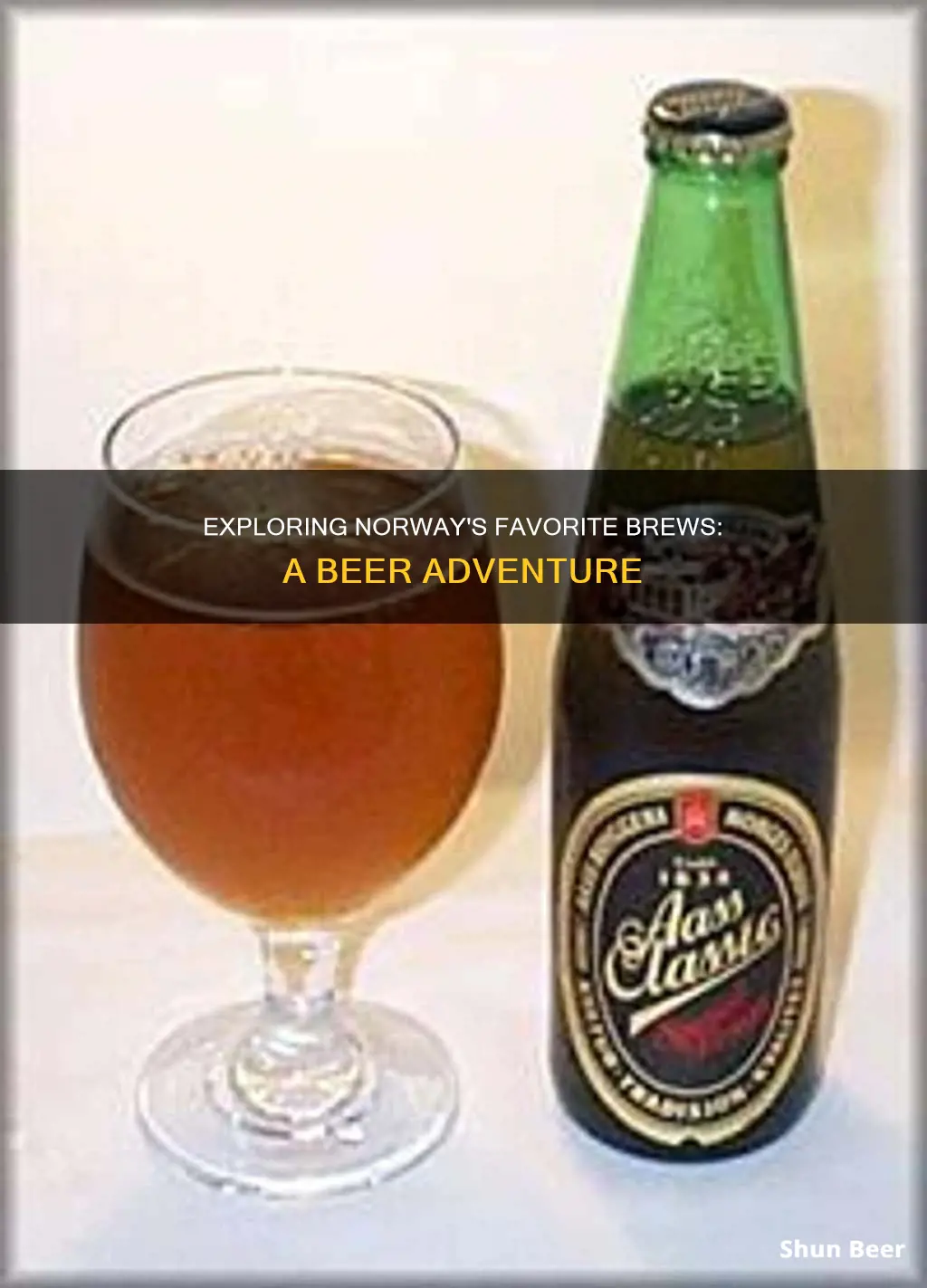
Norway has a rich history of brewing, with beer being crafted and enjoyed in the country for over 1,000 years. The Norwegian beer market is dominated by two large brewers: Carlsberg-Ringnes, based in Oslo and Copenhagen, and Hansa Borg Bryggerier, based in Bergen and Sarpsborg. The most popular style of beer in Norway is pilsner-style pale lager, which is enjoyed in Germany and the Czech Republic. However, craft beers are also gaining market share.
| Characteristics | Values |
|---|---|
| Most popular style of beer | Pilsner-style pale lager |
| Second most popular style of beer | Aass Fatøl |
| Other popular styles of beer | Bayer, Juleøl, Bokkøl, Norsk Gårdsøl, Norsk IPA, Light Lager, Baltisk Porter, Norsk Saison, Håndverksøl, Stjørdalsøl |
| Beer ABV limit in supermarkets | 4.75% |
| Beer ABV limit in pubs, restaurants and nightclubs | No limit |
| Beer ABV limit in state-run liquor stores | No limit |
| Beer ABV categories | Class A (0.7%), Class B (0.7-2.75%), Class C (2.75-3.75%), Class D (3.75-4.75%), Sterkøl (>4.75%) |
| Major brewers | Carlsberg-Ringnes, Hansa Borg Bryggerier |
| Beer price in bars | 65-85kr for 400ml or 500ml |
| Beer price in restaurants | >85kr for 400ml or 500ml |
| Beer price in supermarkets | 25-30kr for 500ml |
| Beer price in state-run off licenses | 30-65kr for 500ml |
What You'll Learn

Pilsner-style pale lager
The most popular style of beer in Norway is the pilsner-style pale lager, which is also the dominant beer type in the country, with almost 92% of the market share. The pilsner style of beer is also popular in Germany and the Czech Republic.
Pilsner is a pale-to-golden lager beer with a well-attenuated body and varying degrees of noble hop bitterness. The main ingredients are water, Pilsner malt, and noble hops, though some brewers use adjuncts such as rice or corn to lighten the body of the beer. The flavour of pilsner tends to be dry, lean, clean-tasting, and crisp, with no traditional beer ingredient dominating the others.
Pilsner was developed in the mid-19th century when Bavarian brewer Gabriel Sedlmayr II the Younger brought British pale ale brewing and malt-making techniques back to the Spaten Brewery in Germany, applying them to existing lagering methods. In 1842, Josef Groll used Sedlmayr's techniques to create the first pale lager, Pilsner Urquell, in Pilsen, Bohemia, Austria-Hungary (now the Czech Republic). The new recipe spread quickly across Europe, and soon other breweries followed the trend, using the name Pilsner. Today, breweries use the terms "lager" and "Pilsner" interchangeably, though pale lagers from the Czech Republic and Germany tend to have a more evident noble hop aroma and dry finish than other pale lagers.
In Norway, the weaker types of pilsner (below 4.75% ABV) are the most common, but most breweries also brew stronger varieties (similar to the Bavarian Spezial beer style) for sale through the Vinmonopol.
Beer and Six-Pack Abs: Can They Coexist?
You may want to see also

Christmas beers
Brewing and drinking Christmas beers have a long history in Norway, dating back to the Viking age. It was once mandatory for all large farms to brew Christmas beer and share it with their neighbours. Today, brewing Christmas beer is a tradition that is continued by virtually every Norwegian brewery, from the largest mainstream breweries to the smallest microbreweries.
Norwegian Christmas beers, known as "juleøl", are typically dark, rich, and strong ales. They are often brewed with the best grain available and can be flavoured with juniper and other herbs. In modern times, each brewery produces its own variety of Christmas beer, mostly a lager. Most breweries brew both weaker varieties (for sale in supermarkets) and more traditional, stronger varieties.
The tradition of brewing Christmas beer in Norway dates back to pre-Christian times. During the Viking age, Norwegians celebrated the winter solstice by brewing and drinking strong, barley-based beer. Brewing Christmas beer became so integral to Viking society that failing to produce a holiday brew became illegal.
In the early 1800s, the Norwegian brewery industry underwent significant changes, with commercial brewing at a large scale displacing home brewing, farmstead brewing, and craft brewing. The first commercial advertisements for Christmas beer appeared in the 1860s and 1870s. During World War II, brewers did not produce Christmas beer due to a lack of resources, and it wasn't until 1956 that Christmas beer was brewed again in Norway.
Today, Norwegian Christmas beers are an important part of the holiday season, with many Norwegians enjoying the tradition of gathering for a "Christmas beer tasting night" to sample different types of juleøl.
Understanding Beer Measurements: Standard Drinks in a Stubby
You may want to see also

Farmhouse brewing
Norway has a rich history of brewing beer, stretching back over a millennium. Until around 200 years ago, most farms brewed their own beer, and brewing was a central element in all religious and social gatherings. Each farm would brew from its own grain, and most larger farms had a separate building for drying grain and malts.
Norway's farmhouse brewing tradition has given rise to several unique styles, known under the common name of "maltøl" (or more recently, "gårdsøl"). These beers are often brewed with ancient yeast strains unique to Norway, known as "kveik".
Kveik yeast is known for its versatility, and farmhouse ales showcase distinctive fruity and spicy flavours. Some examples of farmhouse ales include:
- Stjørdalsøl: a unique, smoked farmhouse ale from the Stjørdal region, brewed with locally smoked malt.
- Heimabrygg: a very strong (8-12% ABV) dark beer from the Hardanger, Voss, and Sogn region, brewed with barley malts, juniper, and often kveik yeast.
- Kornøl: a pale, hazy beer (6-8% ABV) from the Nordfjord and Sunnmøre regions, brewed with barley malts, juniper, and kveik yeast.
In recent years, there has been an explosion of interest in craft beers in Norway, and microbreweries and brewpubs are now a common sight. Many of these craft breweries are reviving old farmhouse brewing traditions and incorporating local ingredients, such as kveik yeast, into their beers.
While the Norwegian beer market is dominated by two large brewers, Carlsberg-Ringnes and Hansa Borg Bryggerier, there are over a hundred microbreweries in the country, especially in major cities. These small local breweries are creating a diverse range of beers, including innovative craft beers and traditional farmhouse ales.
Beer: A Cold Cure or Just an Old Wives' Tale?
You may want to see also

Alcohol restrictions
Beers above 4.7% ABV are only available from licensed premises (bars, restaurants and clubs) or from the Vinmonopolet, a state-run alcohol retail store. This has resulted in many breweries reducing the alcohol content in their beer to make them legal for supermarket retail.
The Norwegian government taxes alcohol at the highest rate in Europe, with all drinks over 0.7% ABV subject to tax. The rates are on a sliding scale depending on the strength of the drink. Beer between 3.7% and 4.7% ABV is taxed at 22.4 kroner per litre, while beer above 4.7% ABV is taxed at 5.01 kroner per percentage point per litre.
The Vinmonopolet is a government-owned alcoholic beverage retailer and the only one permitted to sell beverages containing more than 4.75% ABV. The stores are closed on Sundays, and during the week, they close as early as 6 pm.
In addition to the high taxes, the distribution and availability of alcohol are limited. The Norwegian government's policy goal is to limit alcohol consumption, primarily through high prices and restricted access.
The legal drinking age in Norway is 18 for beverages with an alcohol content of up to 22% ABV, and 20 for anything stronger. Drinking in public is forbidden and punishable by fines.
The regulations around alcohol sales are not unique to Norway. Neighbouring Sweden runs a similar system, where only beer up to 3.5% ABV can be purchased from a supermarket.
Beer and Cholesterol: How Alcohol Affects Medication
You may want to see also

Beer styles
Norway has a long history of brewing beer, stretching back over a millennium. Most farms where grain could be grown brewed their own beer, and brewing was a central element in all religious and social gatherings.
Today, the Norwegian beer market is dominated by two large brewers: Carlsberg-Ringnes, based in Oslo and Copenhagen, and Hansa Borg Bryggerier, based in Bergen and Sarpsborg. However, there are also over a hundred microbreweries in Norway, especially in major cities.
The most popular style of beer in Norway is pilsner-style pale lager, which has around 92% of the market share. However, the craft beer market is developing, and there are a number of different styles available, including kveik yeast beers.
- Pilsner – a pale lager style which originated in the Czech city of Plzeň. The weaker types (below 4.75% ABV) are the most common, but breweries also make stronger varieties.
- Bayer – a dark lager with roots in Bavaria, Germany. The Norwegian version is often slightly sweeter than German dark lagers.
- Juleøl – a dark, malted beer available at Christmas time. Traditionally, this was a strong ale brewed at home, but now breweries produce their own varieties, mostly lagers.
- Bokkøl – a strong, dark lager, typically 6-7% ABV, with a sweet, complex flavour. It is known as Bock bier in Germany.
- Fatøl – a light, easy-drinking beer strongly related to the Pilsner. It is the second-largest beer style in Norway.
- Christmas beer – a wide variety of Christmas beers are produced in Norway, with a range of ABVs, degrees of sweetness, and interesting ingredients. They are usually pretty dark in colour, but there are also gluten-free and non-alcoholic options.
- Summer beer – often light, fully filtered, with a fresh taste and modest bitterness. Some also have wheat malt added for extra fruitiness.
- Wort beer – a dark, alcohol-free beer with a very sweet taste. It is not fermented, so no sugars are converted into alcohol, leaving a high amount of maltose. This drink is popular in Norway due to its high energy content, which is ideal for endurance sports.
- Farmhouse ales – ancient, yeast-driven ales brewed with kveik, an ancient yeast strain unique to Norway. They are known for their distinctive fruity and spicy flavours.
In addition, Norway has a strong tradition of farmhouse brewing, which has resulted in several styles, known under the common name of "maltøl" or "gårdsøl".
Drinking Beer While on Celexa: What You Need to Know
You may want to see also
Frequently asked questions
The most popular beers in Norway include Pilsner, a pale golden lager with a distinct hop flavour; Bayer, a dark malt lager with a sweet flavour; and stronger lagers such as Juleøl and Bokkøl.
Beer in Norway has a long history, stretching back more than a millennium. Until around 200 years ago, most farms brewed their own beer. In the early 20th century, brewing was industrialised and home brewing was restricted. Today, the Norwegian beer market is dominated by two large brewers: Carlsberg-Ringnes and Hansa Borg Bryggerier.
Due to government restrictions, beers above 4.7% ABV are only available from licensed premises (bars, restaurants and clubs) or from the Vinmonopolet, a state-run alcohol retail store. Beers of different strengths are also subject to different taxes, with beer over 0.7% ABV taxed on a sliding scale.







